
The Art of Assemblage: Discovering Found Object Sculptures
Why Found Object Sculptures Transform How We See Art
Found object sculptures represent one of art's most transformative concepts: taking everyday, discarded items and changing them into meaningful artistic statements. These artworks challenge our understanding of what art can be by elevating the ordinary into something extraordinary.
At its core, found object art is created from items not originally designed for artistic purposes. These objects—whether utilitarian, manufactured, or natural—gain new meaning through the artist's selection, presentation, and the context in which they are displayed. Key characteristics include minimal modification of the objects, the rich social history the items carry from their previous use, and the use of democratic, accessible materials.
The concept traces back over a century, with artists like Pablo Picasso and Marcel Duchamp. Duchamp's "readymades," like his famous 1917 "Fountain," were sculptures made from found objects where the act of titling and presenting them transformed them into art.
Found object sculptures speak to those who see potential where others see waste. They transform the mundane into the magnificent, turning discarded items into powerful sculptural statements. This practice continues to evolve, with contemporary artists using everything from beach trash to industrial components to address modern concerns.
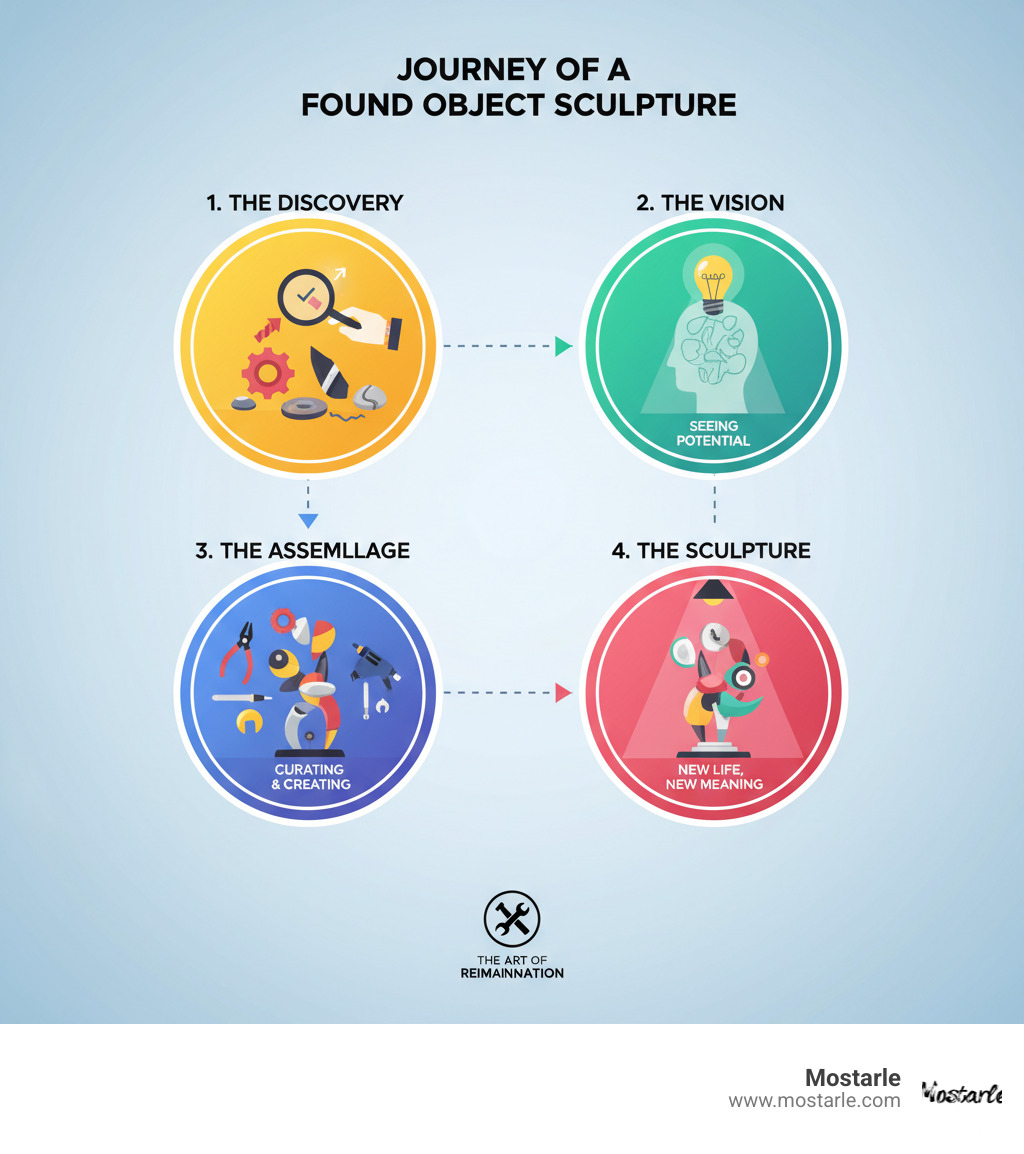
The Genesis of an Idea: A History of Found Object Art
The story of found object sculptures grew from a idea that shocked the art world over a century ago: what if everyday items could become art? Before the early 1900s, art meant traditional materials. The idea of using a bicycle wheel or newspaper clipping was unthinkable.
Pablo Picasso began to change this by gluing bits of newspaper and oilcloth into his paintings, like in his 1912 "Still Life with Chair Caning." He was asking a bold question: why can't real objects be part of art? His famous "Bull's Head" (1942) perfectly shows this magic. He took a bicycle seat and handlebars, put them together, and created the unmistakable form of a bull's head—no carving or bronze needed.
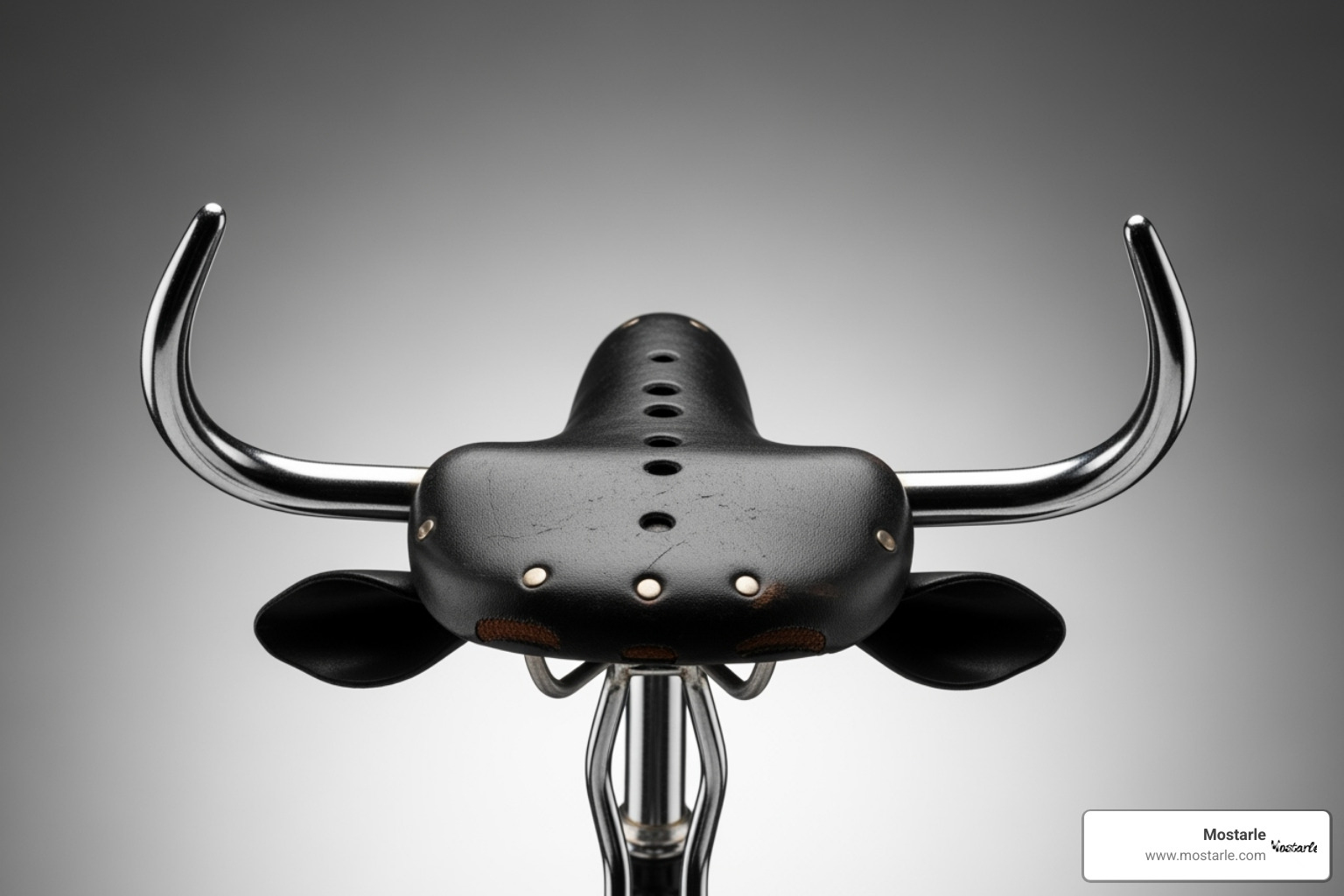
But Marcel Duchamp took things even further, presenting everyday items as complete artworks. This radical approach, which emerged with the Dada movement, questioned everything about traditional art.
Duchamp's 'Readymades' and Their Influence
Duchamp's 'readymades' changed art forever. He argued that by choosing a mass-produced object, giving it a title, and placing it in an art setting, an artist could transform it into art. His first, "Bicycle Wheel" (1913), was a wheel mounted on a stool, its only job to make people think. Then came "Fountain" in 1917—a porcelain urinal signed "R. Mutt." It became legendary, forcing the question: If an artist says it's art, is it art?
Duchamp proved that art could come from ideas, not just craftsmanship. His influence paved the way for conceptual art, pop art, and countless movements. The act of taking an object out of its everyday context fundamentally changed how we think about art. You can explore this pivotal moment deeper at Marcel Duchamp and the Readymade.
Pioneering Movements and Artists
While Duchamp championed the readymade, other movements explored found objects in their own ways. Cubist artists like Picasso and Georges Braque added real materials to their collages, blurring the line between painting and reality.
Surrealist artists, inspired by Freud, used found objects to create startling, dreamlike combinations. Meret Oppenheim's "Object" (1936)—a teacup, saucer, and spoon covered in gazelle fur—is a perfect example. It's both sensual and disturbing. Man Ray's "Gift," an iron with sharp tacks glued to its bottom, is similarly surreal. Meanwhile, Kurt Schwitters developed his "Merz" art by collecting urban debris, proving that beauty could be found in the most overlooked places.
These pioneers showed that an artist's vision mattered more than expensive materials, laying the foundation for all who followed. The Tate Museum defines a Found object defined by Tate as something an artist keeps because they see a special quality others might miss.
From Trash to Treasure: The Core Concepts of Found Object Sculptures
The magic of found object sculptures lies in the ability to look beyond an object's original purpose and find its hidden artistic potential. This change is driven by a few core concepts.
Artistic intent is what separates a pile of junk from a sculpture. When an artist deliberately chooses an object, they are making a statement—perhaps about consumer culture, the beauty of decay, or an object's texture and form. This selection breathes new life into forgotten things. Furthermore, every discarded object carries a social history. A dented hubcap or a faded toy soldier adds layers of meaning, connecting us to the human experiences that shaped them.
This process completely redefines value, turning a broken chair leg from landfill-bound trash into a precious artistic component. The focus shifts from monetary worth to aesthetic, emotional, and conceptual value. It also challenges traditional notions of skill. While technical ability can be important, the real skill is having "the eye"—the vision to spot potential where others see waste.
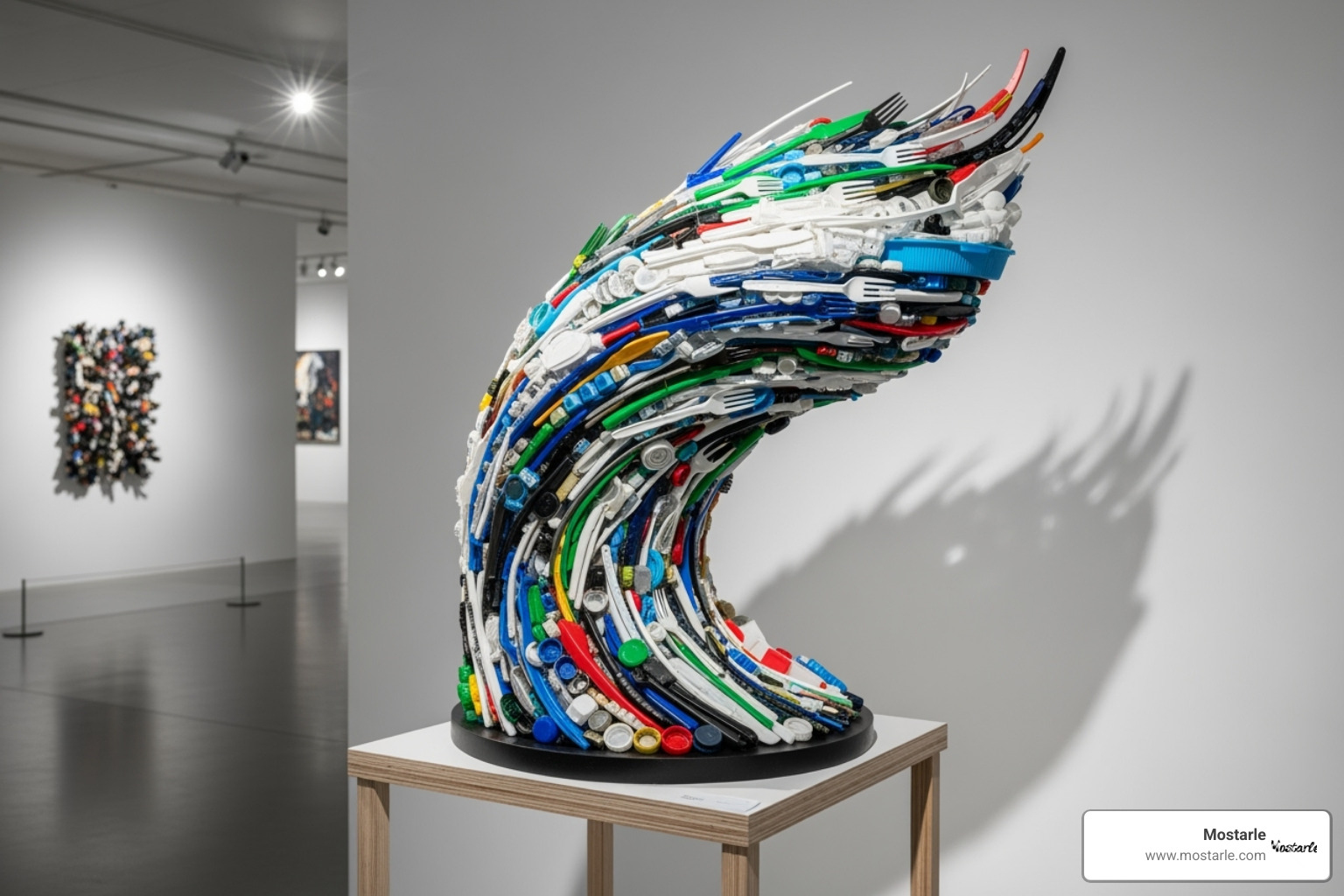
The Significance of Context and Artist's Choice
Context is everything. A rusty wrench in a garage is just a tool. That same wrench mounted in a gallery, dramatically lit, becomes an artwork. The gallery setting signals that we should look more deeply and open ourselves to new interpretations. A title guides us toward the artist's vision. Without the signature and title "Fountain," Duchamp's urinal was just plumbing. With them, it became a landmark of 20th-century art.
This is what happens at Mostarle. We take everyday hardware—nuts, bolts, washers—and through careful selection and arrangement, transform them into intricate sculptures. The artist's eye sees beyond their utilitarian purpose to find their potential for beauty. This shift from utilitarian to aesthetic shows that creativity has no limits. This process of reimagining objects uses the same innovative thinking that drives scientific findy, a concept explored in The Connection Between 3D Metal Puzzles and STEM Education.
How Found Objects Challenge Traditional Art
For centuries, "real" art required expensive materials like marble or fine pigments. Found object sculptures threw out this rulebook by questioning materials traditionally considered "unworthy." A crushed tin can could be as valid a medium as bronze. This shift democratized art, making it accessible to more artists and viewers.
This forced the art vs. non-art debate into the open. It challenged the idea that art must be handmade, suggesting the intellectual act of selection could be as valuable as the physical act of creation. At Mostarle, our metal puzzles embody this philosophy, proving that remarkable creativity can emerge from ordinary materials. This hands-on process connects us to something fundamentally human, as we explore in Why Building Metal Puzzles Might Be the Most Human Thing You Can Do Right Now.
The Spectrum of Assemblage: Types and Techniques
The world of found object sculptures is a vast creative playground where artists combine, stack, and arrange everyday items into something new. This broad approach is called assemblage—bringing different pieces together to create a unified whole. The diversity is incredible, from artists who barely touch their materials to those who completely reconstruct them.
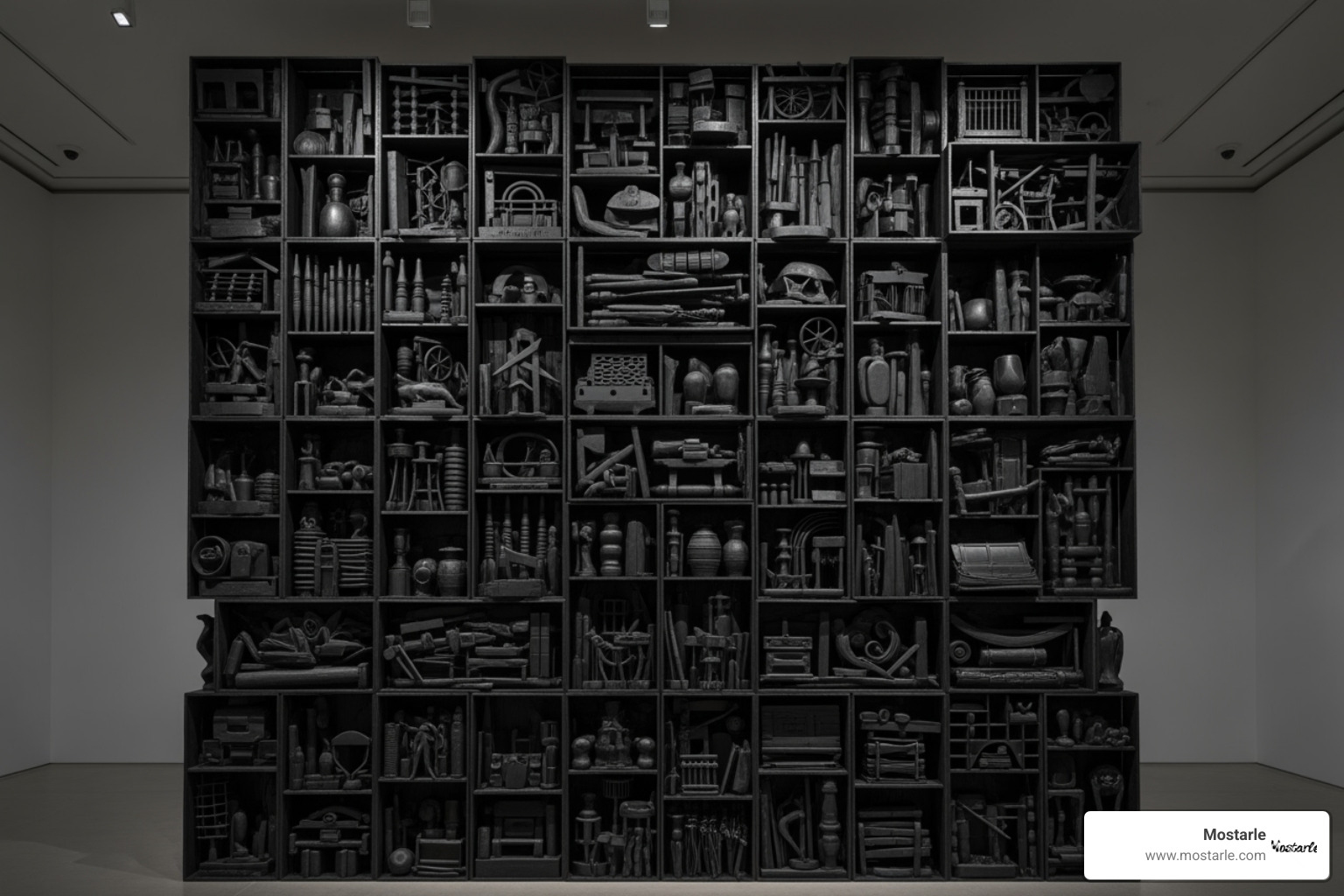
Categories Within Found Object Art
Artists working with found objects fall into several camps.
- Assemblage is the broadest category, where artists combine multiple objects into three-dimensional works. Louise Nevelson mastered this, creating towering sculptures from wooden fragments, all painted a single color to create a mysterious, unified whole.
- Trash art or junk art uses materials rescued from garbage bins to make powerful statements about our throwaway culture.
- Commodity sculpture focuses on new, mass-produced commercial items to comment on consumerism.
- Upcycling gives discarded materials a creative makeover, turning them into something more valuable than their original form.
At Mostarle, our work blends assemblage and upcycling. We take humble hardware—nuts and bolts, screws, and metal fragments—and transform them into intricate sculptures, bringing their hidden geometric beauty into the spotlight. The range of materials is endless: bottle caps, old toys, seashells, and industrial gears have all been turned into art.
Techniques for Creating Found Object Sculptures
Creating these sculptures is part treasure hunt and part engineering challenge. The process begins with sourcing materials, where artists develop a keen eye for potential in thrift stores, construction sites, or flea markets. After cleaning and preparation to reveal the object's character, the real magic happens during joining and assembly. Artists use everything from adhesives and mechanical fasteners (like screws and bolts) to welding for metal pieces.
Finally, composition and balance are key to turning a collection of objects into a cohesive artwork. Artists consider how the pieces relate to each other and ensure the sculpture is physically stable. This entire process exercises the same problem-solving muscles used in puzzle-building, a mental workout that keeps creativity flowing, as we explore in Tickle Your Brain: 3D Puzzles Can Ignite Your Cognitive Skills and Sparkle Creativity.
Modern Masters and Contemporary Visions
The ideas of early pioneers have grown into a rich, evolving art form. From the mid-20th century onward, artists have used everyday objects to create stunning works that tackle everything from personal memories to global issues.
Robert Rauschenberg became famous in the 1950s for his "Combines," which blurred the line between painting and sculpture. He attached real-world objects like tires and beds to canvases, celebrating the beautiful chaos of modern life. In contrast, Joseph Cornell created enchanting shadow boxes—small, glass-fronted cases filled with carefully arranged treasures like old maps and toys, forming miniature worlds of memory.
Artists like David Hammons and Betye Saar brought a powerful social consciousness to the form. Hammons used discarded materials to highlight issues of race and class in urban life, while Saar weaves together found objects and cultural symbols to explore identity and spirituality.
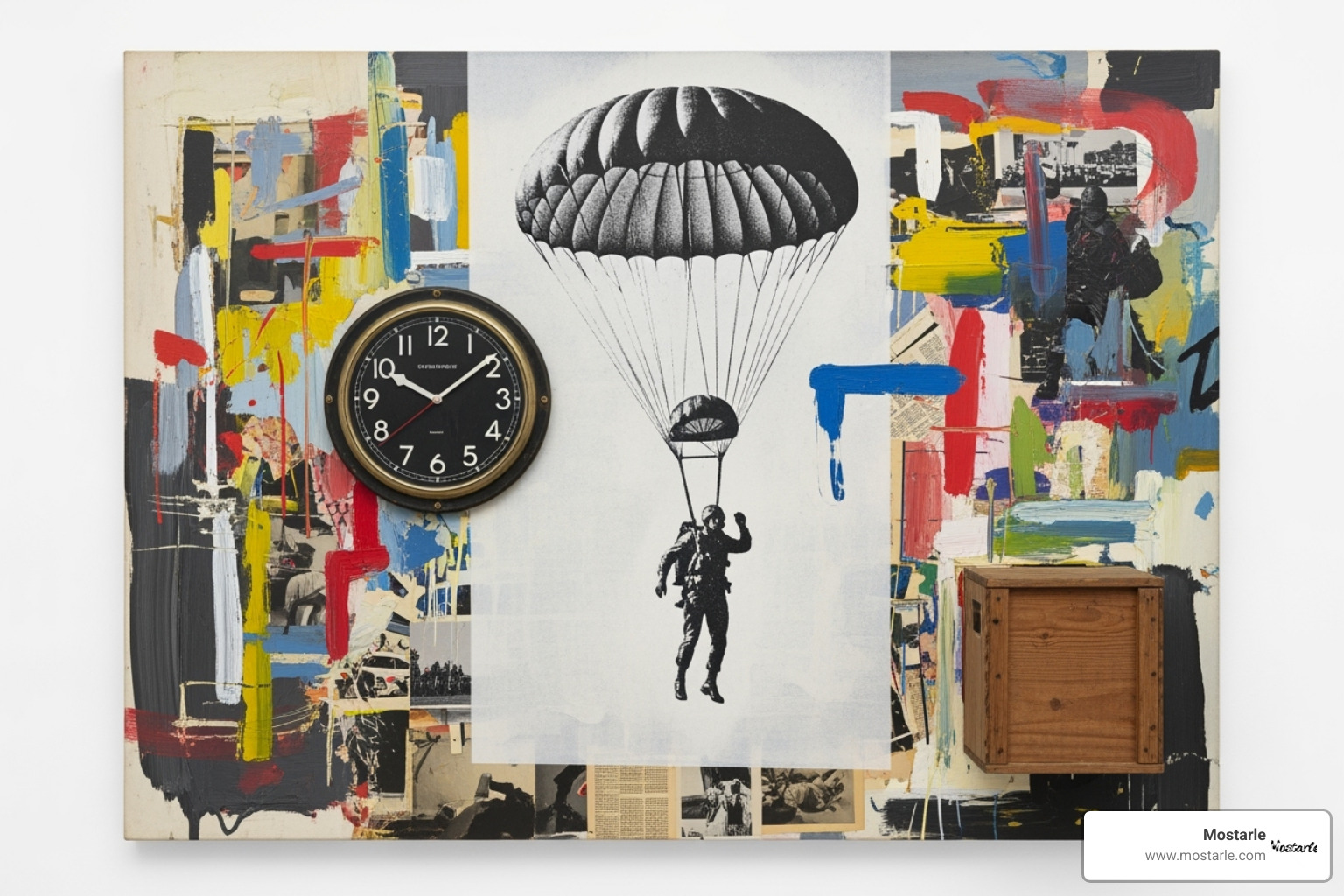
Notable Examples and Contemporary Themes
Some found object sculptures have become iconic. Meret Oppenheim's 'Object' (1936), the fur-covered teacup, remains brilliant in its simplicity, while Man Ray's 'Gift' (1921), an iron with tacks, is both playful and menacing. Damien Hirst pushed boundaries by using biological specimens and even a diamond-encrusted human skull, forcing conversations about mortality and value.
Today's artists continue to find fresh ways to use discarded materials, often addressing pressing issues:
- Environmental commentary is a major theme. Marina DeBris creates beautiful dresses from beach trash to highlight marine pollution.
- Consumer culture remains a rich topic. Vik Muniz recreates famous artworks from garbage, commenting on consumption and waste.
- Personal and cultural identity inspire powerful works. El Anatsui transforms discarded bottle caps into shimmering, mix-like sculptures that speak to African identity and global trade.
At Mostarle, we are inspired by this tradition of seeing the extraordinary in the ordinary. Our metal puzzles, crafted from hardware like nuts and bolts, carry forward this legacy of finding potential where others see only the mundane.
The Great Debate: Criticisms and Conversations
Found object sculptures have always sparked debate. From the moment Duchamp presented his urinal, people have argued whether this is truly art. These conversations are essential, shaping how we think about creativity and skill.
The most common criticisms include:
- Shock value over substance: Critics argue that some artists are just trying to get attention with provocative or bizarre objects, prioritizing headlines over meaningful art.
- Artistic skill versus selection: Many feel that found object art dismisses the years of training required for painting or sculpting. "Where's the skill in picking up a bicycle wheel?" is a common refrain, questioning whether the artist's concept is as valuable as their craft.
- The 'anything goes' argument: Some fear that if everything can be art, then the word "art" becomes meaningless, removing all standards of quality.
Public perception is often the biggest hurdle. When Tracey Emin displayed "My Bed"—her unmade bed with personal debris—the public reaction was explosive. Some saw a raw, honest portrayal of depression, while others saw self-indulgent nonsense.
But these controversies prove that found object art is effective. Its job is to make us think, feel, and question our assumptions. When a rusty piece of metal forces a debate on the nature of creativity, it has succeeded. At Mostarle, our sculptures made from nuts and bolts spark similar conversations about art versus craft. We believe what matters is that ordinary objects can become extraordinary, regardless of the label. These debates keep the art world vibrant and push us all to expand our definitions of beauty.
Conclusion
Our journey through found object sculptures reveals an art form about more than just gluing items together. From Duchamp's urinal to modern installations of ocean plastic, these works push us to question what we consider valuable, beautiful, and meaningful.
The enduring power of change is at the heart of this movement. It's about training our eyes to see the creative potential hiding in plain sight. This philosophy of redefining beauty extends beyond gallery walls, encouraging us to look at our world with curiosity.
At Mostarle, we live this philosophy daily. We are constantly amazed by how ordinary hardware—nuts, bolts, and gears—can be transformed into intricate puzzles and sculptures that spark joy. Our work proves that creativity has no limits when you're willing to see potential where others see utility.
The beauty of found object art is its accessibility. You don't need formal training, just "the eye"—the ability to spot possibilities in unexpected places. This philosophy of seeing potential in the overlooked is a life skill that makes everything more interesting. In our throwaway culture, this perspective is more valuable than ever.
So next time you dismiss an object as worthless, pause. Look at its shape, its texture, its history. You might find that the most extraordinary art emerges from the most ordinary beginnings.
If you're feeling inspired to start your own creative journey, we invite you to experience the magic of change firsthand. Find our insect-themed puzzles and start creating today.